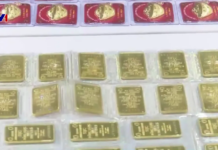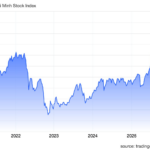The global gold price is volatile within a narrow range, as the yield on US Treasury bonds rises but the USD depreciates in the context of investors waiting for US inflation data, expected to be released this week. However, this morning, the domestic gold price still increased by 500,000-600,000 VND/tael.
By nearly 10 a.m., Phu Quy Group listed the SJC gold bar price for the Hanoi market at 77.4 million VND/tael (buying) and 79.4 million VND/tael (selling). Compared to yesterday morning, the SJC gold bar price at this company has increased by 600,000 VND/tael at each end of the price, bringing the total increase compared to the end of the week to 900,000 VND/tael.
The round smooth ring 999.9 of Phu Quy brand has a price of 64.9 million VND/tael and 66 million VND/tael, corresponding to the buying and selling prices, with an increase of 450,000 VND/tael at each end of the price.
In the Ho Chi Minh City market, SJC Company quoted the gold bar price of the same brand at 77.5 million VND/tael and 79.5 million VND/tael, increasing 700,000 VND/tael and 500,000 VND/tael compared to yesterday morning.
The SJC round smooth ring has a price of 63.75 million VND/tael (buying) and 64.95-65.05 million VND/tael (selling), depending on the weight of the product.
At the same time, the spot gold price in the Asian market increased by $2.7/oz compared to the closing price of the previous session in New York, equivalent to an increase of more than 0.1%, and stood at $2,034.3/oz – according to data from Kitco trading floor. Yesterday evening, the spot gold price closed at $2,031.6/oz, a decrease of $4.7/oz, equivalent to a decrease of about 0.2%, compared to the previous session.
This price is equivalent to about 60.9 million VND/tael if converted according to the selling exchange rate of USD at Vietcombank, an increase of 200,000 VND/tael compared to yesterday morning.
Compared to the converted world gold price, the retail price of SJC gold bars is higher by 18.5-18.6 million VND/tael.
This morning, Vietcombank quoted USD at 24,460 VND (buying) and 24,830 VND (selling), an increase of 10 VND at each end of the price compared to yesterday morning.
The world gold price is under pressure from rising US Treasury bond yields due to expectations that the Federal Reserve (Fed) will maintain higher interest rates for longer. The 10-year US Treasury bond yield closed at 4.299% yesterday, an increase of about 3 basis points compared to the closing level of the previous week.
However, the depreciation of the USD is supporting the gold price. The Dollar Index, which measures the strength of the USD against a basket of 6 major currencies, closed below 103.8 points at the beginning of the week, from nearly 104 points at the end of last week.

Many experts believe that the gold price is mainly dominated by expectations of Fed interest rates, so the report on the core personal consumption expenditures (PCE) index – a measure of inflation preferred by the Fed – expected to be released on Thursday this week will attract special attention from investors.
This week, there will be many important US economic data released and some Fed officials speaking about monetary policy. In addition to the PCE report, there are reports on durable goods orders on Tuesday and wholesale inventories on Wednesday. All of these data will help clarify the state of the US economy, thereby helping investors shape interest rate expectations.
According to Reuters’ forecast, the January PCE of the US increased by 0.4% compared to the previous month.
“If the PCE data is hotter than expected, the gold price will be disadvantaged. However, I believe that the gold price will maintain the $2,000 range. The gold price will only decrease below this level if the economic data this week is unexpectedly strong”, said senior analyst Jim Wyckoff of the Kitco Metal precious metal news site.
According to Wyckoff, the precious metal market is facing technical selling pressure due to a lack of new fundamental information and investors are waiting for new economic data. However, recent statements from Fed officials all indicate that the Fed is not in a hurry to cut interest rates, and this is causing the market to believe that the Fed will not cut interest rates before June. The fact that the Fed maintains higher interest rates for longer is unfavorable for the gold price – an asset that does not yield interest.
Although the January inflation data was weak, the results of the Fed’s March meeting will also be difficult to change, but at least it can “trigger a more serious discussion within the Fed about the timing of the first interest rate cut, and the gold price will benefit from that” – according to senior analyst Craig Erlam of analysis and data firm OANDA.





































